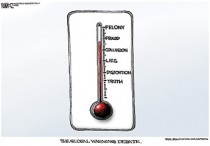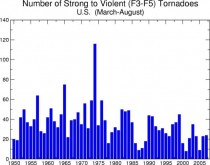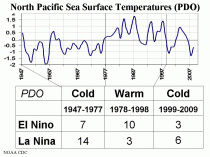By Alan Caruba
The University of Virginia, after vigorously resisting a Freedom of Information Act (FOI) request for data related to the emails of Michael Mann, was the subject of a court order to make them available. While global warming is known worldwide for its claim that manmade warming would doom the Earth, the names and machinations behind the fraud are far less well known.
Mann, a climatologist, was part of a relatively small clique of charlatans who, working for the United Nations Intergovernmental Panel on Climate Change (IPCC), conjured up all manner of “proof” that the Earth was on dangerous trajectory, heating up. Mann invented the “hockey stick” graph that demonstrated this bit of climate magic.
With Al Gore as the most famous face of global warming, Mann and others lent credibility to the IPCC that called for massive reductions in carbon dioxide (CO2) emissions resulting from energy use of fossil fuels, primarily oil and coal.
Mann’s problem began when the “hockey stick” graph was debunked and demolished as bogus. All this occurred while Mann was on the faculty of the University of Virginia and while large amounts of research grant money were being received by the University to support Mann and others.
Since 1990, it is estimated that $100 billion of taxpayer’s funding went to support “climate research” by thousands of scientists who, it turned out, were unable to find and certainly not measure any evidence of human influence on global temperature.
The same thing was occurring across the Atlantic in England where the University of East Anglia was home to Mann’s IPCC co-conspirators. On May 25th, the Guardian reported that Nobel Laureate, Sir. Paul Nurse, complained that the British version of FOI was being used to “harass” some climate scientists by requesting data and other research materials.
Given the collusion of both the University of Virginia and of East Anglia, it should come as no surprise that both institutions held their own boards of inquiry and cleared the climate scientists on their staffs of any wrongdoing. That explains why the court had to drag them into demonstrating the probity of their activities.
This is far from a spat between some universities and their scientists, and “skeptics” challenging the global warming fraud. It most certainly is a fraud when global warming claims are used to impose a huge cost to consumers when utilities and other large emitters of carbon dioxide are required by law to utilize “alternative” sources such as wind and solar power or to install multi-million dollar technologies to needlessly reduce CO2 emissions.
Plainly stated, CO2 emissions have zero effect on the weather or the climate.
David B. Rivkin Jr. and Lee A. Casey, who have brought a law suit, American Electric Power v. Connecticut, all the way to the Supreme Court, note that “It is impossible to determine whether emissions by any particular power plant - or U.S. electricity production as a whole - have affected warming trends and, if so, how.” A decision is pending.
The global warming hoax, which at one point involved a scheme to sell “carbon credits” to industry and businesses so they could continue to emit CO2, enriched those selling the credits in both the U.S. and Europe until the global warming hoax began to implode in November 2009. The exchanges selling the credits closed their doors.
It was in November 2009 that a huge cache of emails between Mann and other IPCC scientists was imported to the Internet where it rapidly became clear that they were very worried that the Earth had entered a natural cooling cycle in 1998 and discussed how to pressure scientific journals to not publish the research of skeptics refuting the hoax.
The IPCC continues to propagate global warming lies, only now it is called “climate change.” Any pubic figure that uses the term “climate change” is lying if for no other reason than the climate of the Earth has been and is always in a state of change.
As courts in the U.S. and England continue to require the global warming charlatans and their universities to make known their alleged “scientific research” and email exchanges to further the hoax, a larger question looms. Should not such activity be deemed a deliberate fraud and should not injured parties, including the whole populations of America and England have a standing in court to see that they are punished?
Unanswered is the role that the mass media played in spreading and defending the global warming hoax. On Memorial Day, when we celebrate the sacrifice of fallen heroes to preserve liberty, the Washington Post published a bizarre editorial criticizing “climate skeptics” for using the FOIA to find out why Mann and the University of Virginia received funding while participating in a massive deception. Unmentioned were comparable Greenpeace FOIA efforts against climate skeptics.
It’s worth noting that the global warming/climate change fraud is still being perpetrated in American schools from coast to coast.
Already, a number of Republican candidates for the presidency have refuted global warming or an earlier role in advocating it. For too long, politicians have not just been wrong, but often deliberately ignorant of the truth.
Justice may be slow, but it will be served and that is a lesson the entire scientific community should take note. As more revelations occur, even the mainstream media will be unable to protect the global warming/climate change perpetrators or to be their co-conspirators.
By P Gosselin on 29. Mai 2011
The German online Die Zeit here takes a look at the series of tornadoes that have ravaged the USA and conducted an interview with US meteorologist and Mississippi State University professor Grady Dixon.
Meteorology professor Grady Dixon: “Terrible mistake” to relate tornado up-tick to climate change. (Photo source: Mississippi State University)
Die Zeit asks the question: “Herr Dixon, is the number of such lethal storms rising in the USA?” Dixon replies:
No, to the contrary. Over the long term the number of deadly tornadoes has even dropped dramatically. [...] However, we have to expect that more people will be hit by tornadoes in the future. Not because there are more storms, but because the population is growing and suburbs and cities are expanding. In any case, 2011 is an unusually violent tornado year and it is just a fluke.”
Dixon is also asked if climate change favors the creation of more tornadoes. Dixon answers:
Research results are mixed on this. [...] But all indications show that it does not necessarily mean that tornadoes will be increasing in frequency.”
On the frequency of tornadoes, Dixon is also quoted by the English-language France 24 here:
“It’s having to do with better (weather tracking) technology, more population, the fact that the population is better educated and more aware. So we’re seeing them more often,” Dixon said.
But he said it would be ‘a terrible mistake’ to relate the up-tick to climate change.”
France 24 also quotes a FEMA official:
Craig Fugate, administrator of the Federal Emergency Management Agency (FEMA), also dismissed Thursday climate change as a factor in the deadly tornadoes: ‘Actually what we’re seeing is springtime,’ he said.
‘Many people think of Oklahoma as ‘Tornado Alley and forget that the southeast United States actually has a history of longer and more powerful tornadoes that stay on the ground longer’.”
Many weeks back I recall Joe Bastardi predicting a humdinger of a tornado season, and of course we now see that his warnings were spot on. This spike in tornadoes is not due to warmth, but to cooling brought on by La Nina, with cold northern air smashing into warm, moist southern air.
David Imy from the NOAA Storm Prediction Center in Norman, Oklahoma adds:
“We knew it was going to be a big tornado year. But the key to that tip-off was unrelated to climate change: It is related to the natural fluctuations of the planet.”
A rare moment of sanity coming from the NOAA? Sorry Romm, but on this one you’re a lone fool (again) out in the desert.
Unrelated: Benny Peiser brings or attention to news that a Global Climate Treaty Is DOA. Looks like Europe will be joining Romm out in the desert.
Note; Two other Ph.D.’s prove that a Ph.D. does not guarantee intelligence or at least that for some dogma trumps common sense in this story.
This is a video of the Canton, OK tornado, 1/2 mile wide taken by original Weather Channel Lead Forecaster, Alan Lipson.
By Anthony Watts, WattsUpWithThat
While Joe Romm, Bill McKibben, and others follow the fear card script to do everything and anything they can to link severe weather to global warming, they are clearly fighting a losing battle for public opinion on the issue. Now, even Andy Revkin at the New York Times doesn’t believe it anymore when it comes to tornadoes.*
He writes:
You can’t exclude climate change, but there’s simply no evidence through a half century of tornado history in the United States of a connection to warming.
Of course one of the strongest pieces of evidence has to do with the trend in the frequency of strong tornadoes, as shown in this somewhat dated graph from NCDC:
I’m looking forward to NCDC updating this data and graph. Obviously, there will be a new spike in 2011 rivaling 1974. But clearly, even with improved detection technology, the trend is down.
But this graph only goes back to 1950, and of course if we presented climate data only back that far, critics like the nefarious “Tamino” aka Grant Foster would have a cherry flavored cow, which is the typical M.O. for him. NCDC of course gets a pass.
Fortunately, I have some new tornado data to present that goes back further.
These two graphs below, courtesy of Dr. Indur Goklany, go back to 1900 and show the trend in death rates yearly, and by decade, since 1900:
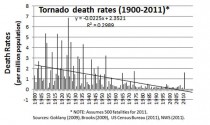
Enlarged
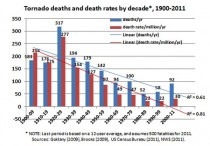
Enlarged
Clearly death rates per million are down, which is testament to the improved warning technology, plus the skills and dedication of the National Weather Service and volunteer storm spotters at getting “eyes on” tornadoes to provide advance warning.
*UPDATE: Andrew Revkin writes in via email with this comment, which I am happy to reprint at his request - Anthony
You’ve cast my concerns about overstated discussions of tornadoes in the context of climate change as if this is new.
You must have missed my 2008 piece, including this section.
----------
Also thanks to Fred Singer and Gordon Fulks
”Decline in Snowpack Blamed on Warming”--headline, Washington Post, Feb. 1, 2008
”Record Snowpacks Could Threaten Western States”--headline, New York Times, May 22, 2011
By: Max Borders 05/27/11 12:25 PM Special to the Examiner
Publicly funded colleges and universities have always fancied themselves as guilds—immune from scrutiny and entitled to privacy. Until now, the public has generally let them off the hook. Not anymore. America’s state-supported “Big U” is in for a rude awakening—a dose of sunlight that will send these fat ‘n’ happy academics scattering into the highest reaches of the ivory towers to evade scrutiny. Don’t believe me? Check out these two stories, which (I hope) are but the tip of the iceberg.
1. Climategate Part Deux—Climate alarmist Michael Mann is kicking and screaming to protect the emails he generated while working at the University of Virginia. Folks involved in a FOIA (Freedom of Information Act) request of Mann’s work are carrying out an ongoing investigation of Mann’s work at UVa in light of Mann’s (and the IPCC’s) very serious Climategate lapses. Most of the probe has centered on Mann’s work while at Penn State, but those interested in sound science would extend that probe further into the past. According to Investors Business Daily:
A state judge has ordered the University of Virginia to cough up documents that pertain to the climate change research of Michael Mann, a former professor known for the hockey stick chart that supposedly shows the earth warming sharply over the last 100 years.
And in the timeless howl of the cold busted, Mann responds with circumstantial ad hominem fallacy:
Mann’s response has been to accuse “fossil fuel industry-funded climate change deniers” with harassing the university, NASA “and scientific institutions with these frivolous attacks.”
Mann obviously has no desire to see more of his dubious methods dragged into the sunlight. Alas, as he was working for the University of Virginia, Mann was a public employee and thus a servant of the people. He thus has no claim to privacy. Indeed, in the spirit of open inquiry and accountability in scientific research, why shouldn’t he be open to scrutiny of his research?
2. Texas Sunlight—“Big U” faculty across the state of Texas are fretting that the University system released a draft document that disclosed to the public details of their salaries. According to this Chronicle of Higher Education article, the faculty are fretting due to “inaccuracies and discrepancies.” My guess is they are fretting because the taxpayers of Texas can see what sort of cushy salaries they’re making, despite a state budget crisis. (And of course, academics will justify their exorbitant salaries based on their inflated self-concepts.)
In my humble opinion (which counts for a little more now that I’m a Texas citizen), salaries are only the beginning. The university should also have to release complete information on all research budgets. Texas faculty know that if the people see how little return they’re getting on all this public research “investment”—and that the students are getting short changed in the process—they will be appalled - and one of the greatest frauds perpetrated against the people of Texas will have been exposed.
But this is likely to to be true not just in Texas, but in every state of the Union. As the costs of higher education continue to spiral out of control, people want to know what they’re paying for. And they deserve to know. (Boy, if they only knew.)
No Guild
Public colleges and universities are not guilds. They are taxpayer supported institutions and they should be thrown open to all manner of scrunity by taxpapers—from what they are teaching in the classroom to what the research budgets are paying for. The faculty will squirm and throw temper tantrums, but if they don’t like it, they can get a job at a private college. I would even go as far as to say that a private university that receives state or federal tax dollars should have to comply with FOIA requests. The more we can bring sunlight into these hallowed halls, the more we’ll see the ergot of waste and corruption we’ve always just assumed wasn’t there. It’s time to audit “Big U.”
Max Borders is a writer living in Austin. He blogs at Ideas Matter.
By Derk Jan Eppink
Last weekend on May 21, American Christian preacher Harold Camping, once again encountered his ‘Disappointment Day’. For years he announced the end of times, predicting May 21 to be Judgment Day. On that day, the world would be destroyed and only ‘a chosen few’ would make it to heaven.
On Judgment Day, the preacher took a seat in front of his television to await news events. He expected a live report of CNN covering a wave of earthquakes that ultimately would lead to global demise.
But nothing happened.
Instead, CNN focused on the Frenchman Dominique Strauss-Kahn who lost his way and senses in a New York hotel room. For ‘DSK’ indeed, the world collapsed. The preacher was disappointed that apocalypses remained confined to only one person and possibly some of his friends in Paris belonging to la gauche caviar. The preacher fled to a motel to escape international media.
Generally, the advantage of religion is that you do not have to take ‘facts’ into account. Like doomsday announcer Camping, you simply believe and preach, hoping that facts will follow. Western political elites live in a secularized world, a world without God. But religion - a matter of belief - does apparently remain a need of human mankind. In particular, progressive political elites have abolished God, while clinging to notoriously religious features like ‘fear’, ‘guilt’, ‘final judgement’, ‘redemption’, ‘sin’ and ‘salvation’, as part of their political philosophies.
God is gone, but the rest stayed on. Climate Change is just an example of this phenomenon. The concept can only be effective if there is ‘guilt’ (politically incorrect behaviour of human mankind), ‘fear’ (doomsday), if there is ‘sin’ (acts of unprincipled unbelievers), and finally salvation (brought about by the NGO´s of the Green Movement). And if there is somehow a substitute Jesus on top, as impersonated by Al Gore, secular religion gets rooted in political communities trying to turn it into public policy all people have to adhere to.
It takes courage to withstand religion-based political philosophies. You will be depicted as a heretic, as anti-human, as narrow-minded, as autistic and stupid. In fact, like in theocracies any opponent should be dispatched to the dustbin of history. When climate change was minted into religion and subsequently put on the political agenda, carefully orchestrated by celebrities and media consultants, it became a wave of self-righteousness. There was no way to escape.
Yet a few risk-daring politicians rose to the occasion. The first was Vaclav Klaus, President of the Czech Republic and a dissident by inclination. He simply raised factual questions secularized religions can hardly cope with.
That is what he did with Communism which was, after all, an elaborated quasi-religious philosophy pretending to lead human mankind to the ‘Promised Land’ on Earth. And here again, even as President of an EU member state he challenged the fundamentals of a policy pretending to save the world from Doomsday.
Many politicians publish books. Very often, these books are written by other people. Very often, these books are glossy and self-glorifying. Very often, these books make no impact whatsoever and they are finally shelved in the basement of the party headquarter. Mostly, these books are dead upon arrival in the bookstore.
Klaus takes on nonsensical thinking regardless of the status of the author himself. In 2009, he visited the European Parliament to tell his audience that they were ‘disconnected’ from reality. He stated that a Parliament without a legitimate opposition is not really a Parliament. In fact, it is a church singing the gospel of the ‘ever closer Union’. Some members were shocked, left the Plenary and started crying in the corridor. Yesterday, Ivo Belet one of those weeping members, published an opinion article in a Flemish newspaper denouncing NVA-figurehead Bart De Wever for meeting the Anti-Christ from the Czech Republic. Belet, a slavish poodle of EU figureheads, is barking up the wrong tree. The European elite demand flattery and praise; not to criticism, let alone unconventional thinking.
It takes courage to challenge fashionable thinking. For 5 years, I worked in the cabinet of former Commissioner Frits Bolkestein. The Dutch Commissioner was a non federalist and a climate change sceptic in the Commission. For most of his colleagues he was the ‘devil in disguise’. You can imagine the bumpy ride he had in Brussels; he was a ‘non believer’ in a church of devoted federalists.
Once he got a letter from former Belgian Commissioner, Etienne Davignon, a self-appointed viceroy of the United States of Belgium, who said that a non federalist should not be member of the European Commission. He demanded a purge to restore the purity of the Institution.
Ten years ago, Bolkestein publicly said that the Euro would derail if not underpinned by sound monetary policy and iron-clad criteria of the Stability and Growth Pact. He also stated that a common EU immigration policy based on unenforced external borders would generate a political backlash beyond belief. He was laughed at. But now, the political elite of the EU is not laughing anymore. They wasted ten years of policy-making and still, they would rather drive into a brick wall than to admit that they made mistakes.
Jean Marie Dedecker equally has the courage to stick out his neck. As a former Judo player and coach he is not risk adverse. On the contrary, he likes the fray and smashing his opponents on the ground, sooner the better.
And that is precisely why he has written the introduction to the Dutch version of the book President Klaus is launching here today. He belonged to the first in Belgium to challenge the preachers of doom and climate change. Belgium only recently abolished God, and for those who were still in doubt some catholic leaders and priests did the rest.
Flanders was in urgent need for a religious substitute that would be able to micromanage the lives of the people. Obviously, Dedecker was vilified by the political elites and the media which had turned into an extension of the green movement and its preachers in politics.
Both Klaus and Dedecker focused on facts, rather than on speculation and emotional manipulation. They challenged the issues head-on by raising difficult questions, and by doing so they gradually saw the narrative of climate change unravel. Later on, a series of scandals revealed that so-called scientific researchers had manipulated their work in order to serve the dogmas of their beliefs. The Copenhagen Summit resulted in failure and, demonstrations against climate change even had to be cancelled because it was to cold and frosty in the Danish capital.
Now, climate change does not have that mythical spot on the political agenda it had a few years ago. However, it remains on the agenda of political elites in the EU. Some people really do believe; others simply pretend in order to sustain a quasi-progressive image. But the man in the street never embraced climate change and why? The climate has been changing as long as there is a climate, even in times in which people were running around naked and living in caves. One slight change in the activity of the Sun has an impact on the entire galaxy. Human behaviour is just one of the many elements. Therefore, the religious zeal did not stick because ‘human guilt’ could not be established. And ‘guilt’ is what it takes to make a religion work, even a religion without a God.
Therefore, a democracy needs people like Klaus and Dedecker, people who speak out when nobody does, people who stand out when others follow the flow and people who lash out when many bend towards submission. This book will certainly be a much welcome recipe against political overheating in Flanders and the reality-check which is the necessary basis for any sound public policy. H/T Chris Horner
Think repealing oil industry tax incentives will increase federal revenues? Think again.
By Paul Driessen
President Obama frequently says Americans “need to end our $4 billion in annual taxpayer subsidies to oil companies.” The latest Democrat bill would have repealed some $2 billion of what Senator Charles Schumer (D-NY) and others call “subsidies” and “special tax breaks” for Big Oil.
That’s baloney - shameless demagoguery that will inflict further damage on our struggling economy.
Subsidies are cash payments from government to the private sector. Money is taken from the 51% of Americans who still pay income taxes - and transferred by legislators and bureaucrats to companies and activities that “deserve” or “require” these wealth transfers, because the recipients perform an important service and/or could not remain in business unless subsidized with other people’s money (OPM).
The petroleum industry does not receive “subsidies” to produce oil and natural gas. It doesn’t even get “special tax breaks” or outright tax credits. What are falsely described in these terms are actually tax deductions for costs incurred by companies in the process of exploring, drilling, producing and refining the oil and natural gas that energize this nation’s economy and living standards.
These tax deductions are equivalent or similar to deductions claimed by every US business, large and small, for things like facilities depreciation, equipment, utilities, payroll, and research and development. They are intended to ensure that businesses, like individuals, recover their costs and get taxed only on their net incomes. For oil companies those deductions include:
* Geological and geophysical costs, for exploration to assess prospects prior to drilling;
* Intangible drilling costs - equipment, labor, fuel and supplies associated with drilling expensive wells;
* Expensing “tertiary injectants,” water and chemicals injected into older wells to keep them producing;
* Domestic manufacturer’s deductions of up to 6% of income earned from extracting oil and gas (farmers, manufacturers and other producers can deduct up to 9% of earned income);
* Percentage depletion allowance, allowing for gradual recovery of up-front investments in a petroleum (or iron, gold, limestone, et cetera) deposit that is gradually extracted and depleted. The allowance is no longer (since 1975) available to “integrated” companies that produce, refine and market oil.
White House, congressional and eco-activist claims that repealing these deductions will generate “billions in new revenues” reflect an abysmal grasp of basic business, economic and behavioral principles.
Thankfully, more Americans are beginning to understand that repealing any or all of these deductions will increase oil companies’ individual project and overall operating costs. That means future bonus bids will decline, wells won’t be drilled, fewer deposits will be profitable enough to develop, and wells and fields will be abandoned prematurely. Oil and gas will be left in the ground, crews will lose jobs, tax and royalty payments will dwindle, and the USA will send billions more overseas for imported oil.
Informed Americans also recognize that, in 2008, oil and natural gas provided 61% of the energy that powers America. Natural gas generates almost a quarter of our electricity. These fuels provided affordable energy 24/7/365, supported 9.2 million jobs, kept millions off welfare and food stamp rolls, and generated billions in revenue for federal, state and local governments.
Wind and solar combined accounted for barely 0.6% of total US energy, and 1.9% of electricity generation, in 2008 - providing expensive, intermittent, heavily subsidized energy 8/6/312 or less.
In subsidies per unit of energy actually produced, gas-fired electricity generation got 25 cents per megawatt-hour in 2007 subsidies; coal received 44 cents (mostly for clean technology research). By comparison, wind turbines got 23.4 dollars and photovoltaic solar received 24.3 dollars per MWh.
One project alone - the $2-billion Shepherds Flat wind farm in north-central Oregon will transfer $500 million in hard cash subsidies, plus a subsidized loan guarantee of $1.1 billion to White House friend Jeffrey Immelt, General Electric and their partners. These OPM subsidies equal 80% of the $2-billion in tax breaks that Senators Reid and Schumer are so exercised about. The contract was GE’s largest in FY 2009. (Ethanol subsidies totaled nearly $6 billion in 2010, three times the senators’ target.)
Shepherds Flat will be the world’s largest wind farm: 338 gigantic 2.5 MW turbines, 97 miles of new roads and 167 miles of high voltage transmission lines sprawling across 32,000 to 83,000 acres (up to twice the size of Washington, DC) of the scenic Columbia River Gorge area. At best, the turbines may average one-third of the 2.5 MW stamped on their nameplates. At the whim of the winds, the farm will generate electricity at wild swings between zero and the turbines’ combined rated capacity of 845 MW.
That’s about one-quarter to one-half of what a single modern coal, gas or nuclear power plant generates 90-95% of the time, day after day, all year long … from a tiny fraction of the wind farm’s land area.
As is the case with Pacific Northwest hydroelectric, Four Corners coal and Arizona nuclear power, Shepherds Flat will supply electricity for Southern California, so that state can maintain its lifestyle, meet its lofty renewable energy goals and be “green,” by using energy generated in someone else’s backyard.
Building and installing the turbines will require some 1.5 million pounds of rare earth metals (from Mongolian areas devastated by mining and smelting the metals), plus at least 700,000,000 pounds of concrete, steel, copper and fiberglass… accompanied by the fossil fuel energy, pollution and CO2 associated with mining, smelting and manufacturing these materials. The turbines will impact scenery and wildlife habitats, and kill numerous bats, falcons, hawks, eagles, owls, egrets, herons, ducks and curlews.
However, environmentalists, legislators and regulators treat those impacts - as well as noise, human health, airspace, Defense Department and other concerns - very differently from the way they handle hydrocarbon projects. In their quest for “green” energy at any cost, they simply brush these issues aside.
Our taxpayer subsidies are financing all of this, and generating impressive profits for their recipients. GE, for instance, generated over $5 billion in US profits in 2010 - but paid no US income taxes.
Compare this to Big Oil companies, which likewise made big profits last year… but also paid big taxes. ExxonMobil, for example, earned $30.5 billion in profits in 2010, on revenues of $383 billion, and paid $1.6 billion in US income taxes. Its combined lease bonuses, rents, royalties, taxes and other payments to the US Treasury totaled almost $10 billion last year. The company also paid state and local levies.
Overall, a Tax Foundation analysis of Energy Information Agency data shows, the largest integrated oil companies paid $1.95 trillion in corporate income, severance, property, excise and sales taxes, between 1981 and 2008. During that time, those companies’ total combined profits (net of taxes and expenses, and after adjusting for inflation) were $1.4 trillion - or 40% less than they paid in total taxes.
The “green” agenda - to use mandates, subsidies, regulations and taxes to coerce a shift to “renewable” energy and “fundamentally transform” our energy, economic and social structure - is rationalized largely by fears of “dangerous manmade global warming.” It is deceptive, costly, environmentally harmful, and devoid of genuine scientific evidence to support its alarmist claims.
Europe’s catchy “20-20-20” climate action plan (20% renewable energy, 20% reduction in overall energy consumption, 20% cut in greenhouse gas emissions, by 2020) carries a minimum price tag of OPM $300 billion. It may reduce average global temperatures by 0.1 degree F (0.05 Celsius) by 2100 … assuming climate change is actually driven by carbon dioxide, rather than by multiple, complex natural forces.
Only mad dogs, environmentalists, liberal Democrats and RINOs would buy into such nonsense.
Paul Driessen is senior policy advisor for the Committee For A Constructive Tomorrow and Congress of Racial Equality, and author of Eco-Imperialism: Green power - Black death.
Similarly see Larry Bell’s insightfiul story in Forbes on “Getting Hosed At the Pump? Don’t Dare Blame Obama”..
Safety experts have warned that ash from an erupting Icelandic volcano that closed the country’s airspace may blow across large swathes of western Europe, raising fears of new flight chaos.
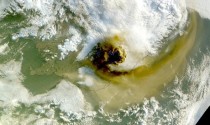
Air safety officials said ash from the Grimsvotn eruption may reach north Scotland by Tuesday before sweeping across Britain to hit France and Spain two days later, as experts said the impact should not be as far-reaching as 2010 when a similar event caused widespread flight cancellations.
Ash deposits were sprinkled over the capital Reykjavik on Sunday, some 400 kilometres to the west of the volcano which spewed a cloud about 20 kilometres into the sky. Residents living near to Grimsvotn said the skies had turned black in an eerie echo of last year’s eruption of the smaller Eyjafjoell volcano which led to the biggest global airspace shutdown since World War II.
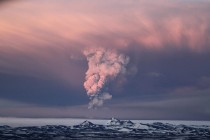
“It’s just black outside, and you can hardly tell it is supposed to be bright daylight,” Bjorgvin Hardarsson, a farmer at Hunbakkar Farm in the nearby village of Kirkjubaejarklaustur said by phone.
“It’s been very dark. You’d think it was night,” agreed Vilhelm Tunnarsson, a photographer for local Icelandic media staying at a nearby hotel, adding at times he had been unable to see 30 centimetres in front of him.
“I went out a little this morning, and had ash in my eyes and mouth and nose. And I just went five metres to my car and back ... I was covered,” he said, describing how he and others at the hotel had tried to cover doors and windows with mattresses and towels to block the ash.
Rescue workers have been hard at work handing out masks and helping local farmers with their animals since Grimsvotn, Iceland’s most active volcano located at the heart of its biggest glacier Vatnajoekull, began erupting late on Saturday. Ash soon covered nearby villages and farms and by Sunday morning invisible deposits had reached the capital, prompting Iceland’s airport authority, Isavia, to announce the main airport Keflavik was shutting.
The airspace closure “affects pretty much all of Iceland right now ... Flights to and from Iceland are shutting down,” Isavia spokeswoman Hjordis Gudmundsdottir said, adding that flight routes to the north of the North Atlantic island might also eventually be affected.
Gudmundsdottir said the closure would remain in force until at least 6pm (0400 AEST) . See more at the UK Guardian and Sydney Morning Herald.
However, she stressed, the fact that winds were blowing the ash to the north were far better than last year’s eruption of Eyjafjoell, when a massive cloud of ash was blown to the south and southeast over mainland Europe.
Saturday’s eruption was the most powerful in over a century at Grimsvotn, which has erupted nine times between 1922 and 2004, a spokeswoman for the Icelandic Meteorological Office said. The eruption, which was far more powerful than the Eyjafjoell blast and its plume peak of nine kilometres, was meanwhile already showing signs of tapering off, spokeswoman Bergthora Njala Gudmundsdottir said.
“It seems like the activity is declining quite rapidly at the moment,” she said, pointing out that Grimsvotn’s plume now stood at between 10 and 15 kilometres. “That is still a quite powerful eruption, but the history of the volcano area shows that it is usually quite powerful for one or two days and then less powerful,” she said, stressing though that “how it will be a day from now is impossible to say, but we are hoping it will calm down”.
The plume of smoke and ash meanwhile still reaches “above the tropopause (the atmospheric boundary between the troposphere and the stratosphere) where most of weather happens, so there is still a danger that the ash can travel,” Elin Jonasdottir, an aviation expert at the Meteorological Office, said.
But experts said the ash generated by the latest eruption might be of a different nature, although an official analysis has not been completed. “I don’t expect this will have the same effect as Eyjafjoell volcano because the ash is not as fine,” geologist Gunnar Gudmundsson said. “The eruption is still going strong, but because the ash is basalt it is rougher and falls back down to earth much quicker.” When it last erupted in November 2004, volcanic ash fell as far away as mainland Europe and caused minor disruptions in flights to and from Iceland.
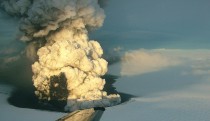
Grimsvotn eruption in 2004 (enlarged)
The eruption in 1996 was stronger.
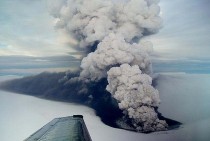
High latitude eruptions have an effect summer and winter on the hemispheric climate. In the last 4 years, we had Kasatouchi, Redoubt, Sarychev and then last spring Eyjafjoell erupt. They all affected to some degree the winters and summers. High latitude volcanoes tend to favor high latitude blocking which means colder winters and cool summers. Low latitude volcanoes do not have the high latitude blocking related severe winters though summers are cool and wet.
It definitely reached high enough to make a difference. the straatosphere is much lower in the polar regions than the tropics. 65,000 feet is well into the stratosphere. It is not so much the ash which tends to fall out more rapidly as the sulfur dioxide that become sulfate aerosols which last longer and reflect incoming solar radiation. See the write up from two years ago here.
Alarmists and the media like to tell us the arctic warming is unprecedented and can only be explained by greenhouse gas theory. We have posted stories on the site like this one and one with Joe D’Aleo and George Taylor in About Climate Change arguing the multidecadal cycles in the ocean possibly related to solar are the real drivers with much better correlations. This following post is excellent.
Global Warming Science
NASA’s James Hansen (Hansen et al 2007 “Climate simulations for 1880–2003 with GISS modelE” Clim Dyn (2007) 29:661–696 [PDF ]observed that the climate model was not correctly simulating the 1930s-1940s warm period in the global average temperature: “It may be fruitless to search for an external forcing to produce peak warmth around 1940. It is shown below that the observed maximum is due almost entirely to temporary warmth in the Arctic. Such Arctic warmth could be a natural oscillation (Johannessen et al. 2004), possibly unforced. Indeed, there are few forcings that would yield warmth largely confined to the Arctic. Candidates might be soot blown to the Arctic from industrial activity at the outset of World War II, or solar forcing of the Arctic Oscillation (Shindell et al. 1999; Tourpali et al. 2005) that is not captured by our present model. Perhaps a more likely scenario is an unforced ocean dynamical fluctuation with heat transport to the Arctic and positive feedbacks from reduced sea ice.”
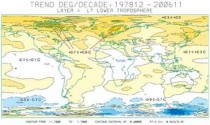
So Hansen asserts that the previous warming cycle was natural (perhaps “solar forcing of the Arctic Oscillation"), but the current warming cycle is due to CO2. And yet the current “global” warming has also been “largely confined to the Arctic”.
The following figures compare the annual average temperature anomaly data for the Arctic for NOAA GHCN (unadjusted) and Hadley CRUTEM3 (adjusted and averaged over 5x5 degree grids) through 2010. All stations or grids north of 65N with data extending from before 1930 to after 2000 have been included. (Plotted )
GHCN - 29 stations

Hadley Arctic stations
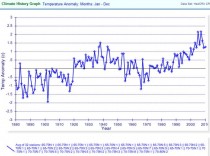
The following figure compares the above two figures with GHCN in blue and CRUTEM3 in red. Hadley/CRU adjustments result in reduction in past warm years in the 1920s-1940s and slightly warmer temperatures in the mid-2000s.
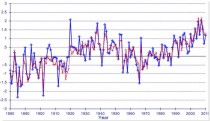
The following figure shows the GHCN temperature anomaly data (blue) along with the same data shifted back 69 years and down 0.3 degrees (red).
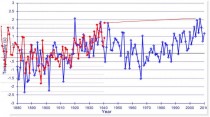
This shows the similarity of the cycles and may portend 25 years of cooling before the warming resumes.
The following figure shows the AMO+PDO superimposed on the Arctic average annual temperature shown at the beginning of this document.
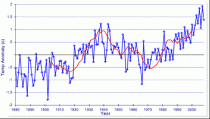
Read much more on the reason for the cycle in this story and on the Icecap links above.
The UK government, having boldly gone where no other government has been before and introduced a regime of legally binding emissions cuts, has now accepted the Committee on Climate Change’s recommended carbon budget for 2023-27. This goes beyond what other EU Members States are committed to, and was achieved despite some public opposition from ministerial ranks. The belief is that a threat from Greenpeace to try for a judicial review if the committee’s recommendation was rejected may have tipped the balance: this was one risk that the Coalition could well do without at present.
The decision is tempered by a review being scheduled for 2014, as a sweetener for those (including Vince Cable) who fear for the competitiveness of UK industry if the rest of the world fails to follow Britain’s lead. Politics being the art of the possible, it is quite likely that the final decision was in effect a way to reduce the flak from the green lobby, while leaving enough wriggle room to keep internal critics on side, without there being an intellectual commitment to the underlying scientific advice. Or it could be that David Cameron and colleagues genuinely buy into the currently received wisdom from the IPCC.
If so, they will not have been swayed by the refusal of the global climate to work in the way the way that computer models predict. Temperatures have remained pretty level since the turn of the century, with mainstream climate science failing to come up with any credible explanation. At heart, the argument rests on a single ‘fact’; that only the enhanced greenhouse hypothesis is able to explain the pattern of warming during the twentieth century. Others - sceptics, realists or ‘deniers’ depending on your world view - have repeatedly questioned this assumption, but have as yet failed to provide hard evidence that any other mechanism may also be at the root of the pattern.
That now seems about to change. There have been various theories advanced relating to the influence of solar variability. After all, essentially all the thermal energy the Earth receives is by way of radiation from the Sun, so this seems like a good place to start. One particularly intriguing suggestion has been championed by Henrik Svensmark and Eigil Friis-Christensen of the Danish Space Research Institute, who suggested in 1997 that the Sun might have an indirect effect on cloud formation and thus average temperatures.
According to this hypothesis, high energy cosmic rays may penetrate the atmosphere to a depth sufficient to cause nucleation of water vapour and hence cloud formation at low-level. But the constant stream of cosmic rays is mediated by the solar wind, a variable flow of atomic particles from the Sun which partially deflects the incoming radiation. When this is strong, fewer cosmic rays reach the Earth, which results in fewer clouds and hence higher temperatures because more solar radiation hits the ground. Conversely, if the solar wind is weak, the greater flux of cosmic rays causes more clouds to form, which reflect more sunlight and reduce temperatures.
Of course, it’s not quite as simple as that, but those readers who would like to learn more can do so in an admirably clear and accessible book by Svensmark and his co-author, Nigel Calder, called The Chilling Stars - A new theory of climate change. But the Svensmark hypothesis has remained controversial, since it calls into question the very basis of the IPCC’s efforts and, more particularly, the policy of reducing carbon dioxide emissions to mitigate climate change. It has not found widespread acceptance, but now supporting evidence is starting to make it impossible to ignore.
In 2007 (also the year that The Chilling Stars was published) the results of an experiment in Copenhagen called SKY were published by the Royal Society. This was the first controlled demonstration of the ability of gamma rays (in this case, highly penetrating muons which create bursts of electrons) can rapidly induce formation of aerosols in air containing water vapour and a naturally occurring low level of sulphuric acid. But this was not enough to convince proponents of the anthropogenic global warming hypothesis that there might be an alternative explanation for climatic variation.
One criticism of the original SKY experiment was that the source of particles (penetrating gamma radiation) was not the same as cosmic radiation. But now collaborative work between scientists at the University of Aarhus and the Danish National Space Institute has gone further and used high energy particles generated by an accelerator to achieve the same effect (see Scientists at Aarhus University (AU) and the National Space Institute (DTU) show that particles from space create cloud cover). The high energy electrons created in this way are much more akin to natural cosmic rays, and the fact that they show the same ability to create aerosols strengthens the case that the Svensmark hypothesis is worth further study.
The release from Aarhus University is quite clear:
“New input to the United Nations climate model: Ulrik Ingerslev Uggerhøj, Physics and Astronomy, AU, along with others including Jens Olaf Pepke Pedersen and Martin Bodker Enghoff, DTU Space, have directly demonstrated in a new experiment that cosmic radiation can create small floating particles - so-called aerosols in the atmosphere. By doing so, they substantiate the connection between the Sun’s magnetic activity and the Earth’s climate.”
Predictably, there has been little publicity for the new findings and no renewed public questioning of the current received wisdom. But that may change later this year when the first results come from a major experiment at CERN called CLOUD. This will use a much larger chamber and be able to generate even more data on the effect of various types of particles on aerosol and cloud formation. If the results are consistent with those obtained in Aarhus, then they will be impossible to ignore. Readers may be interested in following Nigel Calder’s updates on the issue.
Not that this conclusively ‘proves’ the Svensmark hypothesis, but it certainly provides hard evidence that the proposed mechanism is right. This means that, on one hand, we have a plausible hypothesis (the enhanced greenhouse effect) which has no hard supporting evidence but the belief in which is based on the outputs of computer models, while on the other hand we have an alternative hypothesis which is equally plausible and which is supported by hard evidence. The IPCC and governments simply cannot continue to be blinkered. Failure to take this seriously could take the developed world up the biggest policy dead end in history.
See also a productive debate between alarmists (from PIK) and realists (EIKE) in Germany as translated by P. Gosselin in No Tricks Zone’s Skeptics And Alarmists Clash At Climate Conference - EIKE German Scientists Call PIK Scientific Position “Weak”.
Fred Dardick Thursday, May 19, 2011
There is a very good chance the Earth is barreling towards another Little Ice Age within the next 10 to 30 years, perhaps sooner, and you wouldn’t know it by turning on the television. A calamitous event that could lead to widespread crop losses and the starvation of millions is being covered up by complicit climate scientists and the main stream media because it doesn’t fit with the politically correct narrative that humans are responsible for out of control global warming.

US Winter temperatures the last decade. Cooling at a rate of 4.13F per decade. Enlarged
Predicting the coming cooling is pretty straightforward. There have been numerous heating and cooling periods in world history that have been linked to entirely natural solar, ocean, and atmospheric cycles.
The 60 year Atlantic Multidecadal Oscillation (AMO) ocean cycle is now entering a cooling phase. Between 1968 and 1972 the AMO was estimated to cause a 0.3 degree Celsius drop in Northern hemisphere temperatures.
The North Atlantic Oscillation (NAO), an atmospheric phenomenon that influences Northern hemisphere temperatures, has just begun a 30 year cooling phase.
The most important influence on global temperatures, the sun, appears to be entering an extended period of decreased sunspot activity. While the exact mechanism is still under debate, the correlation between solar sunspot cycles and global temperatures has been well documented.
The previous solar cycle 23 had a length of 12.6 years, much longer than the historical average of 11 years. Especially long solar cycles are often followed by cooler global periods. Combined with solar cycle 24, which may have already reached solar maximum after only 2.5 years of activity, the sun appears to be mirroring the beginning of the Dalton Minimum 1790 AD to 1830 AD which burdened Europe with a number of especially long and cold winters and poor growing seasons.
We are in the midst of the convergence of 3 major solar, ocean, and atmospheric cycles all heading in the direction of global cooling. Last year the Southern hemisphere experienced its coldest winter in 50 years and Europe just went through two particularly cold winters in a row, and the cooling trend has only just begun. The likelihood of a repeat of the Year Without a Summer in 1816 or The Great Frost of 1709 is growing with every day.
With billions more people to feed than ever before, mass starvation becomes a very real possibility in the case of large scale crop losses. All the modern technology in the world can’t make a bean stalk grow if the ground is frozen stiff.
Even though disaster is staring the world in the face, far too many climate scientists remain beholden to liberal anti-human politics to do anything useful about it. At a time they should be sounding the warning siren for society to prepare for possible food and energy shortages, most still amazingly insist that an insignificant atmospheric molecule (CO2) is more responsible for warming the Earth than the Sun.
Fred Dardick is the owner and operator of a medical staffing company based in Chicago. Prior to the business world, he worked as a biological researcher at Northwestern University and The University of Chicago. He has BS and MS degrees in biology and maintains a blog at conservativespotlight.com.
Patrick Michaels is a senior fellow in Environmental Studies at the Cato Institute and the editor of the forthcoming Climate Coup: Global Warming’s Invasion of our Government and our Lives, as well as the author of several other books on global warming.
His Forbes column on the Chevy Volt is a case study in the nexus between big government corruption and big business rent-seeking.
Michaels briefly recaps the well-known consumer fraud in which GM has touted the Volt as an all-electric mass production vehicle on the supposed basis of which its sales receive a $7, 500 taxpayer subsidy, which still renders it overpriced and unmarketable.
Michaels notes that “sales are anemic: 326 in December, 321 in January, and 281 in February.”
There seems to be a trend here.
Michaels adds that GM has announced a production run of 100,000 in the first two years and asks what appears to be a rhetorical question: “Who is going to buy all these cars?”
But wait! Keep hope alive! There is a positive answer to the question.
Jeffrey Immelt’s GE will buy a boatload of those uneconomic GM cars. Here the case study opens onto the inevitable political angle: Recently, President Obama selected General Electric CEO Jeffrey Immelt to chair his Economic Advisory Board.
GE is also awash in windmills waiting to be subsidized so they can provide unreliable, expensive power. Consequently, and soon after his appointment, Immelt announced that GE will buy 50,000 Volts in the next two years, or half the total produced.
Assuming the corporation qualifies for the same tax credit, we (you and me) just shelled out $375, 000, 000 to a company to buy cars that no one else wants, so that GM will not tank and produce even more cars that no one wants. And this guy is the chair of Obama’s Economic Advisory Board?
But of course. Michaels includes this hilarious detail in his case study:
In a telling attempt to preserve battery power, the heater is exceedingly weak. Consumer Reports their tests averaged a paltry 25 miles of electric-only running, in part because it was testing in cold Connecticut. (The [GM] engineer at the Auto Show said cold weather would have little effect.) It will be interesting to see what the range is on a hot, traffic-jammed summer day, when the air conditioner will really tax the batteries. When the gas engine came on, Consumer Reports got about 30 miles to the gallon of premium fuel; which, in terms of additional cost of high-test gas, drives the effective mileage closer to 27 mpg. A conventional Honda Accord, which seats 5 (instead of the Volt’s 4), gets 34 mpg on the highway, and costs less than half of what CR paid, even with the tax break.
The story of the GM Volt deserves a place in the Harvard Business School curriculum....but of course, it won’t. It’s a classic tale of the GOVERNMENT deciding what the public needs, not the marketplace.
Freedom is lost gradually by an uninterested, uninformed, and uninvolved people.
By Steve Milloy, May 16, 2011, The Daily Caller
If you’re thinking of becoming a GOP presidential candidate - and who isn’t these days? - you can plan on being pressed on the climate issue.
In the wake of last week’s new report from a panel of the National Research Council (NRC) reiterating its old talking points on climate, The Washington Post editorialized that all (read “Republican") candidates for political office should be quizzed about whether they agree with the “scientific consensus of America’s premier scientific advisory group.”
Though this threat is intended to intimidate Republicans who tend toward queasiness when confronted with environmental issues, the attack is easy to parry and then even to counterattack - that’s why Al Gore and his enviros duck debating so-called climate skeptics.
First, let’s dismiss a couple of the faulty premises of The Post’s editorial.
While it is true that the NRC operates under the umbrella of the National Academy of Sciences, the NRC panel that authored the report has nothing to do with the prestigious individual scientists who comprise the National Academy of Sciences membership. NRC panels are highly politicized and often stacked, and no climate skeptics were included in the panel that wrote last week’s report.
Next, science doesn’t work on a consensus basis. We don’t accept that the Earth revolves around the Sun because most scientists, or a group of scientists, have agreed to say so. Science is driven by data, not groupthink.
In actuality, the NRC report is more of an exercise in political rather than climate science.
Skeptics don’t deny global warming or climate change. We think the atmosphere probably has warmed slightly and on an average basis over the past 200 years (for unknown reasons), and we recognize that climate is continually, albeit slowly, changing.
We don’t agree, however, that manmade emissions of carbon dioxide (CO2) and other greenhouse gases are having either detectable or predictable effects on climate - and we have at least two key means of establishing this point.
First, atmospheric CO2 concentrations have increased by about 8 percent or so since the mid-1990s. According to climate alarmists, this should have caused measurable global warming. But none has been observed, a fact that was finally admitted by climate alarmists in the wake of the ClimateGate scandal.
Next, if it were true that global temperature was so sensitive and dependent upon atmospheric CO2 levels, then climate models (essentially elaborate scientific formulas) could be constructed so as to accurately predict the temperature effects from changing CO2 levels. But not only do existing models not predict the future temperature, they can’t predict the past when historical data is put through them.
But shouldn’t we err on the side of precaution and reduce emissions anyway? As the U.S. Environmental Protection Agency has already demonstrated and admitted, we could shut down the U.S. in terms of CO2 emissions for 100 years, and we would make precious little difference in atmospheric CO2 level - possibly on the order of 5 percent.
Given that an 8 percent increase in CO2 over the past 15 years has amounted to zero global warming, candidates would be on firm ground wondering whether a 5 percent increase over 100 years is worth wrecking the economy over.
Candidates should not fall for bogus distractions like melting polar ice, threatened polar bears, bad weather and the like.
The Washington Post wants candidates to be quizzed on what they would do about “the rising seas, spreading deserts and intensifying storms that, absent a change in policy, loom on America’s horizon.”
But natural disasters, topographic changes and population booms and busts have always occurred and will continue to occur. Moreover, none of these phenomena can be scientifically tied to manmade emissions of CO2. So they are simply irrelevant sideshow issues.
Carbon dioxide should also not be referred to as a “pollutant.” It is colorless, odorless, and tasteless and is an essential nutrient for plants and, therefore, humans. Alarmists call it “carbon pollution;” the rest of us call it “life.”
One last science point is the ClimateGate scandal. Alarmists claim that numerous subsequent investigations of the matter by independent groups have failed to uncover wrongdoing or faulty science. But none of these whitewashes were truly independent or anything more than superficial. No input from skeptics, even those mentioned in the emails, was included.
None of this is difficult to learn and or articulate. Yet ask almost any Republican politician about any of this and the best you can hope for from them is an expression of concern about jobs and/or the fact that China and India aren’t cutting their emissions.
While those are true and valid points, they too are sideshow distractions. The central point of the science debate is whether manmade CO2 emissions are causing harm. There is no evidence that they are.
People often ask, “What if you’re wrong about the science?” or “Shouldn’t we err on the side of better-safe-than-sorry?” But of course it’s the alarmists who need to be second-guessing themselves. They’ve been repeatedly wrong and never right since they started forecasting climate doom almost 25 years ago. Given them no quarter.
Steve Milloy publishes JunkScience.com and is the author of “Green Hell: How Environmentalists Plan to Control Your Life and What You Can Do to Stop Them.”
-------------
Dr. Richard Lindzen responded to a letter by the NAS’s Ralph Cicerone and Martin Rees, head ot the Royal Society that previewed the NAS report. It included the statement:
Our academies will provide the scientific backdrop for the political and business leaders who must create effective policies to steer the world toward a low-carbon economy.
Dr. Lindzen interprets this:
Rees and Cicerone are saying that regardless of the evidence the answer is predetermined. If the government wants carbon control, that is the answer that the Academies will provide. Nothing could better epitomize the notion of science in the service of politics (and other interests distinct from science as well) - something that, unfortunately, has characterized so-called climate science.
And he adds Inevitably in climate science, when data conflicts with models, a small coterie of scientists can be counted upon to modify the data.
Cicerone recently noted that whatever the administration wants the NAS to find, they will oblige. The NAS is no longer what Abe Lincoln who founded it, had in mind.
UPDATE: More heavy snow in California Sierra’s Squaw Valley has reached well over 700” of total snow accumulation-- something that has never happened in Squaw Valley’s recorded history. Get out there and enjoy the incredible spring conditions. See the snowfall tracker for record-setting 2010/11. See the record spring western snowpack here. Another nail in the coffin for the most scientifcally flawed paper ever published by the AMS, and endorsed by the EPA, NOAA and the IPCC. The snow (up to 18 inches) this weekend cancelled a bike race and another storm will follow the next three days with another foot or two of snow. Early spring snowmelt is another pillar the AGW built their church on. Read more on the western snows and eastern cold rains on Weatherbell.
By Paul Gregory
The New York Times outdid itself in media bias on Friday the 13th. It reported that “the nation’s scientific establishment” as represented by the National Research Council has reaffirmed that “global warming is real” and that “its effects are already becoming serious.” The NYT warns that we must act now because “adverse changes in the climate system...may be impossible to undo.”
The NYT regrets that “the answer comes at a time when efforts to adopt a climate-change policy have stalled in Washington, with many of the Republicans who control the House expressing open skepticism about the science of climate change. Other legislators, including some Democrats, worry that any new law would translate into higher energy prices and hurt the economy.”
For those few and uninformed skeptics, the NYT assures us that “Not only is the science behind the climate-change forecast solid, but the risks to future generations from further inaction are profound.” Already, “the sea level is rising in many American towns” and the average United States air temperature has increased by two degrees in the last 50 years.
The only skeptic cited is Texas Representative Joe Barton, who “swiftly dismissed the council’s findings.” But pay no attention to Barton. We are informed he is “leading the charge against further regulating carbon emissions,” presumably a stooge for Texas’s “Big Oil.” (A photo of a scowling Barton is attached to the article).
According to the NYT, the committee itself “is an unusual combination of climate scientists, businessmen and politicians,” and even includes “non scientist, Jim Geringer, a conservative Republican.” Such a committee would clearly bend over backwards to be fair.
The report ends on an unsurprising note. America’s greatest scientists recommend that the federal government spend a gazillion dollars on scientific and engineering research before it is too late.
Well, anyone can read the summary of the Research Council’s report on line, which I did. Here is what I found in a few minutes of research:
1) On the Committee:
Of the first eight names, only one appears to be a climate scientist. The others are engineers, lawyers, and public policy types. There are other names, but I did not want to waste my time. I presume the pattern holds. No top climate change skeptic, like MIT’s Richard Lindzen, is included. This report was not written by climate scientists but by public policy wonks.
2) On the certainty of the science:
The report tells us, contrary to the NYT account, that the science is far from certain. I quote: “How will the climate system respond to increased greenhouse gases? The exact value of ‘climate sensitivity’ - that is, how much temperature rise will occur for a given increase in atmospheric greenhouse gas concentration - is uncertain due to incomplete understanding of some elements of the earth’s climate system.” Note the wobbly use of language, such as “exact” or “some elements,” to signal that the science is “almost certain.” I can imagine the illustrious committee members searching for appropriate qualifiers that would not let the cat out of the bag.
3) If the science is uncertain, why act now?
The report, which is not a study of climate science but of risk management, argues that the potential environmental damage from temperature increases (which the committee admits we really do not understand) is so large that we cannot afford to wait until we understand the science. (With this argument, we should wipe North Korean and Iran off the map now because of the future risk of their future nuclear weapons).
4) How about the NYT’s claim of “rising sea levels in many American towns?”
Not surprisingly, I could not find this is in the report (perhaps it is hidden some where). There is only a general reference to risks to coastal areas from future rises in sea levels. The NYT’s claim is puzzling. How can sea levels be higher in one coastal town and lower in another nearby town? I’d like the NYT writer (Leslie Kaufman) to explain that one. (I do recall an earlier NYT report with “Rising Sea Levels and Global Warming” in the headline, but it turned out to be subsidence. The earth was inconveniently dropping not the sea level rising).
The NYT is again trying to tell us that the science is certain and that anyone who disagrees is a stooge or an idiot. If global warming alarmism is so scientifically proven, why is it that respected top scientists at institutions such as M.I.T., Princeton, Harvard, Pennsylvania, Virginia and Wisconsin say there is no scientific evidence to support it? Has the Times ever tried to answer this question? Global warming alarmism should not be taken seriously until and unless the question is satisfactorily answered.
Why should a layman give global warming alarmism any credence if these scientists do not? Post.
By Joseph D’Aleo, CCM, WeatherBell Analytics Chief Forecaster
Texas is experiencing what may be their worst drought in history based on October to April rainfall thanks to a strong La Nina and a cold PDO. 76% of the state’s winter wheat was rated poor to very poor in this week’s report.
How about long term trends? Well given the cold PDO which favors more frequent and longer La Ninas has started its likely two to three decade domnance, drought is likely to be a more frequent visitor to the state in the next decade or two than it was in the El Nino rich PDO warm phase from 1979 to 1998.
Let’s look at the longer term trend. Here we will refer to the work of Texas State Climatologist John Neilson Gammon and his Assistant State Climatologist, Brent McRoberts.
Reference: Neilson-Gammon, J., 2011: Our New Analysis of United States Precipitation Trends. Climate Abyss Chron Blog.
Issues with the Climate Division data compiled from COOP stations were addressed by the authors in their attempt to better assess long term precipitation across the United States. Though climate models suggest increasing drought across the southern states, the cleaned up data showed instead long term positive trends and the likelihood that the changes were due largely to natural variability.
John Neilson Gammon, the state climatologist for Texas, notes :“The COOP network is our primary source for climate data for the United States since the 1890s. Observations include daily maximum and minimum temperatures, precipitation, and snowfall. A unique aspect of the COOP network is that almost all of the observations are taken by volunteers, making it an impressive example of coordinated, dedicated effort having an enduring impact.
There are two primary ways that COOP data get combined into coherent, long-term data sets. One is by using a subset of stations that have particularly long-term records: the United States Historical Climatology Network (USHCN). The other is by combining the COOP observations into regional averages, known as climate divisions.
The climate division data is the most common tool for monitoring month-to-month variations in the climate. When the National Oceanic and Atmospheric Administration (NOAA), which by the way administers the COOP network, says that Texas had the driest seven consecutive months on record this past October through April, they’re using the climate division data to make that statement.
There’s one big problem with using the climate division data to make that sort of statement, or to determine in general how climate has changed over time: COOP stations come and go. Volunteers move, or stop taking measurements. New volunteers might live in a wetter or warmer part of the climate division, making the new climate division averages wetter or warmer than before. Plus the climate division data before 1931 was reconstructed based on statewide averages because many parts of the country didn’t have enough stations within each climate division”.
Barry Keim (the Louisiana State Climatologist) and others have looked at a few parts of the country and found that these sorts of changes can seriously affect the long-term record. Brent McRoberts, Assistant Texas State Climatologist estimated the precipitation at every COOP station site whenever an actual observation was unavailable. He used periods when station data overlapped with neighboring station data to determine the correlation between adjoining stations, and used the most highly correlated stations for estimating any missing data.
Reference: McRoberts, D.B, Nielsen-Gammon, J.W,, 2011, New Homogenized Climate Division Precipitation Data Set for Analysis of Climate Variability and Climate Change, Journal of Applied Meteorology, Submitted August 2010, Accepted for publication 2011. (doi: 10.1175/2010JAMC2626.1)
The resulting climate division precipitation averages, which we called FNEP data, are more accurate than the standard NOAA climate division averages.
Another characteristic of the FNEP data is that the resulting long-term trends in precipitation are more consistent from state to state. Furthermore, we examined a few examples of differences between FNEP and the regular COOP, and each difference was attributable to changes in the station distribution or the 1930 change. Here;s what thee FNEP data shows:
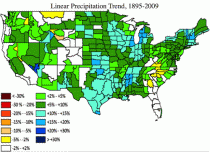
Enlarged.
Greens and blues are upward, yellows and reds are downward. The transition from dark green to light blue corresponds to an upward trend of 10% per century.
Most of the United States has had an increase in recorded precipitation over the past 115 years of record-keeping. Gammon estimated that part of the increase (maybe 3%) could be due to improved rain gauge technology reducing evaporation out of the gauge, but the rest of it appears to be real. The only areas without a strong trend are the northern Rocky Mountains and parts of the Southeast. Nowhere is there a substantial downward trend.
The author notes: “This trend pattern is not consistent with the climate projections for increasing Tyndall gases, which basically have the northern United States getting wetter and the southern United States getting drier. There’s no sign of the long-term drought that’s supposed to be gripping the Southwest, although to be fair the rising temperatures in the region are increasing evaporation.”
The Texas upward trend may be surprising to those living through what might turn out to be one of the worst droughts on record. But think about the worst drought years:1917-1918, 1925, and 1951-1956. It was much drier before the 1950s than after. Our recent dry years have alternated with very wet years.
That can be seen in the NCDC Texas Climate-at-a-Glance annual precipitation. It exhibits a slight upward trend of 0.08 inches/decade for the period form 1895 to 2010.
Summary: The NCDC Coop station based data and FNEP analysis show the recent October to April period the driest in record for Texas, an analysis of long term trends showed no increase in drought but instead a positive precipitation trend.
A thorough analysis of precipitation data across the United States shows a tendency for increases over the last century. This is true even in the southern United States where greenhouse theory suggests increasing drought and dryness. The authors had no definitive reason why the precipitation does not behave as climate models predict, speculating modeling errors, natural variability, or other factors not properly considered such as aerosols or irrigation/land use changes.
The PDO related alternating favored ENSO state and the significant correlation of Texas preicpitation with ENSO suggests despite this upward trend, a higher frequency of Texas drought in the La Nina dominate years ahead.
See also Global Scan of Impact Areas, this week’s crop progress report and more on this post on WeatherBell. See WeatherBell’s Joe Bastardi on Fox Business this afternoon on his weekly weather impact review.
A recent peer-reviewed paper published in Astronomy & Astrophysics finds that solar activity has increased since the Little Ice Age by far more than previously assumed by the IPCC. The paper finds that the Total Solar Irradiance (TSI) has increased since the end of the Little Ice Age (around 1850) by up to 6 times more than assumed by the IPCC. Thus, much of the global warming observed since 1850 may instead be attributable to the Sun (called “solar forcing"), rather than man-made CO2 as assumed by the IPCC.
Total Solar Irradiance (TSI)
Astronomy & Astrophysics 529, A67 (2011)
A new approach to the long-term reconstruction of the solar irradiance leads to large historical solar forcing
A. I. Shapiro, W. Schmutz1, E. Rozanov, M. Schoell, M. Haberreiter1, A. V. Shapiro and S. Nyeki
1 Physikalisch-Meteorologishes Observatorium Davos, World Radiation Center, 7260 Davos Dorf, Switzerland
2 Institute for Atmospheric and Climate science ETH, Zurich, Switzerland
3 Institute for Astronomy ETH, Zurich, Switzerland
Received: 19 November 2010 Accepted: 22 February 2011
Abstract
Context. The variable Sun is the most likely candidate for the natural forcing of past climate changes on time scales of 50 to 1000 years. Evidence for this understanding is that the terrestrial climate correlates positively with the solar activity. During the past 10 000 years, the Sun has experienced the substantial variations in activity and there have been numerous attempts to reconstruct solar irradiance. While there is general agreement on how solar forcing varied during the last several hundred years - all reconstructions are proportional to the solar activity - there is scientific controversy on the magnitude of solar forcing. Aims. We present a reconstruction of the total and spectral solar irradiance covering 130 nm-10 μm from 1610 to the present with an annual resolution and for the Holocene with a 22-year resolution. Methods. We assume that the minimum state of the quiet Sun in time corresponds to the observed quietest area on the present Sun. Then we use available long-term proxies of the solar activity, which are 10Be isotope concentrations in ice cores and 22-year smoothed neutron monitor data, to interpolate between the present quiet Sun and the minimum state of the quiet Sun. This determines the long-term trend in the solar variability, which is then superposed with the 11-year activity cycle calculated from the sunspot number. The time-dependent solar spectral irradiance from about 7000 BC to the present is then derived using a state-of-the-art radiation code. Results. We derive a total and spectral solar irradiance that was substantially lower during the Maunder minimum than the one observed today. The difference is remarkably larger than other estimations published in the recent literature. The magnitude of the solar UV variability, which indirectly affects the climate, is also found to exceed previous estimates. We discuss in detail the assumptions that lead us to this conclusion.





